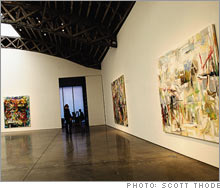(Fortune Magazine) -- Great wealth generally finds art at some point," observes Marianne Boesky, fresh off the slopes in Aspen. She would know: As a well-known Manhattan dealer and the daughter of infamous financier Ivan (she's in Colorado with Dad to celebrate his 70th birthday), Boesky is at the nexus of two colliding galaxies: Wall Street and the art world.
Her husband, trader Liam Culman, "is a Wall Street guy, and he had never been in a contemporary art gallery until we met," she says. "But as soon as he started understanding the numbers and seeing the margins, he became serious about art." And his Wall Street buddies? "At first they were like, 'What is this crap?'" says Boesky. "Now they're on my waiting lists."
 |
| Mary Boone has reigned supreme over the art world for decades. Her gallery typically showcases large canvases, and her shows are always sold out. |
It's a story that's playing out up and down the cobblestone streets of the formerly gritty neighborhood known as West Chelsea. In 1996 there were ten galleries in the area. Today, in part because of the flood of hedge fund, private-equity, and investment-banking money, there are more than 300, according to Art & Auction magazine.
Lines for the Armory Show, a New York City art fair in late February, ran seven blocks long and took two hours to get through. "We've never been mobbed like that before," says Bill Wood, assistant director of the Pace-Wildenstein gallery. "As a colleague said, 'If you can't make money now in the art world, you're in the wrong business.'"
As more and more Wall Streeters discover collecting - a 2007 Prince & Associates survey of 200 Wall Street professionals with bonuses that averaged $5 million found that 12 percent was spent on art - gallery hopping has turned into a macho, competitive sport.
"It used to be the wives who came in with their fabric swatches," says art advisor Blair Clarke. "Now the husbands are taking a break from work to look at art." The other benefit of collecting, of course, is the cachet: "It opens up a whole social network for people," says Boesky. "You end up participating in museum boards and acquisition committees, so you meet a lot of like-minded people."
Veterans of transparent markets, however, often find the art world - with its aloof galleristas and hush-hush waiting lists - somewhat difficult to navigate. Art consultant Sandy Heller likens the art world to a small Chinese bank IPO - not everyone who has the money can get in. Most of the work in a gallery - especially anything by hedge fund favorites Barnaby Furnas, Richard Prince, and Takashi Murakami - is already sold. If it does happen to be available, there is a pecking order.
"They think we're crazy," says art advisor Lowell Pettit. "We'll be in some dumpy gallery on the far west side of Manhattan, and they can't buy any of the paintings!" That's led to some nasty spats, such as the one between hedgie Dan Loeb and gallery owner Barbara Gladstone. (He felt he had been promised a Matthew Barney photo; she disagreed.) Most galleries say that the ideal buyer isn't the highest bidder but rather someone who will hold the work for a long time, then donate it to a museum.
At least one financier is buying to hold: Glenn Fuhrman, who manages Michael Dell's family money and has become an active collector and philanthropist, is opening an exhibition space in Chelsea to display works from private collections, including his own.
_______________
Investors zoom in on photography 